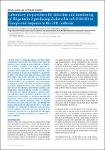Laboratory preparedness for detection and monitoring of Shiga toxin 2-producing Escherichia coli O104:H4 in Europe and response to the 2011 outbreak
Rosin, Polyia
Niskanen, T.
Palm, D.
Struelens, M.
Takkinen, J.
A hybrid strain of enteroaggregative and Shiga toxin 2-producing Escherichia coli (EAEC-STEC) serotype O104:H4 strain caused a large outbreak of haemolytic uraemic syndrome and bloody diarrhoea in 2011 in Europe. Two surveys were performed in the European Union (EU) and European Economic Area (EEA) countries to assess their laboratory capabilities to detect and characterise this previously uncommon STEC strain. Prior to the outbreak, 11 of the 32 countries in this survey had capacity at national reference laboratory (NRL) level for epidemic case confirmation according to the EU definition. During the outbreak, at primary diagnostic level, nine countries reported that clinical microbiology laboratories routinely used Shiga toxin detection assays suitable for diagnosis of infections with EAEC-STEC O104:H4, while 14 countries had NRL capacity to confirm epidemic cases. Six months after the outbreak, 22 countries reported NRL capacity to confirm such cases following initiatives taken by NRLs and the European Centre for Disease Prevention and Control (ECDC) Food- and Waterborne Disease and Zoonoses laboratory network. These data highlight the challenge of detection and confirmation of epidemic infections caused by atypical STEC strains and the benefits of coordinated EU laboratory networks to strengthen capabilities in response to a major outbreak.
Dateien zu dieser Publikation
Keine Lizenzangabe
Verwandte Publikationen
Anzeige der Publikationen mit ähnlichem Titel, Autor, Urheber und Thema.
-
2014-03-13ZeitschriftenartikelMortality and molecular epidemiology associated with extended-spectrum β-lactamase production in Escherichia coli from bloodstream infection Leistner, Rasmus; Sakellariou, Christian; Gürntke, Stephan; Kola, Axel; Steinmetz, Ivo; Kohler, Christian; Pfeifer, Yvonne; Eller, Christoph; Gastmeier, Petra; Schwab, FrankBackground: The rate of infections due to extended-spectrum β-lactamase (ESBL)-producing Escherichia coli is growing worldwide. These infections are suspected to be related to increased mortality. We aimed to estimate the ...
-
2017-11-13ZeitschriftenartikelRisk of Transmission of Antimicrobial Resistant Escherichia coli from Commercial Broiler and Free-Range Retail Chicken in India Hussain, Arif; Shaik, Sabiha; Ranjan, Amit; Nandanwar, Nishant; Tiwari, Sumeet K.; Majid, Mohammad; Baddam, Ramani; Qureshi, Insaf A.; Semmler, Torsten; Wieler, Lothar H.; Islam, Mohammad A.; Chakravortty, Dipshikha; Ahmed, NiyazMultidrug-resistant Escherichia coli infections are a growing public health concern. This study analyzed the possibility of contamination of commercial poultry meat (broiler and free-range) with pathogenic and or multi-resistant ...
-
2014-04-10ZeitschriftenartikelResults of surveillance for infections with Shiga toxinproducing Escherichia coli (STEC) of serotype O104:H4 after the large outbreak in Germany, July to December 2011 Frank, Christina; Milde-Busch, Astrid; Werber, DirkAfter the massive outbreak of infections with Shiga toxin-producing Escherichia coli (STEC) of serotype O104:H4 in Germany in the summer of 2011, post-outbreak surveillance for further infections with this type of STEC was ...

